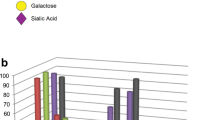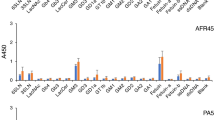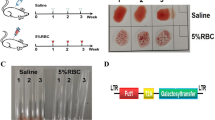Abstract
TUMOUR cells synthesise and release antigenic membrane associated components which circulate either in a free state or complexed with host immunoglobulins1–5. A membrane derived N-like glycoprotein, which inhibited Vicia graminea lectin haemagglutination, has been demonstrated in serum and ascites fluid of mice bearing the Ha subline of TA3 murine mammary adenocarcinoma6. Springer et al.7 have shown that M and N blood group reactive substances were present in both benign and malignant lesions of the human breast. But, T-like Arachis hypogaea reactive substances were only found in malignant breast tissue and not in benign tumours or healthy breast tissue7. Isolation and long term cultivation of a human mammary tumour cell line. BOT-2 was recently reported8. Immunological tests indicated that women with diagnosed mammary cancer had circulating antibodies that reacted with these cells9 and induced cell surface shedding10. Here we report the use of blood-typing antisera and lectins to characterise the proteins synthesised and spontaneously released from BOT-2 cells growing in defined medium. To our knowledge this is the first demonstration of M, N, T, Tn erythrocyte-like glycoproteins being spontaneously shed from human epithelial tumour cells in culture.
This is a preview of subscription content, access via your institution
Access options
Subscribe to this journal
Receive 51 print issues and online access
$199.00 per year
only $3.90 per issue
Buy this article
- Purchase on Springer Link
- Instant access to full article PDF
Prices may be subject to local taxes which are calculated during checkout
Similar content being viewed by others
References
Hollinshead, A. C. et al. Cancer 34, 1235–1243 (1974).
Currie, G. A. & Basham, C. Br. J. Cancer 26, 427–438 (1972).
Thomson, D. M. P. & Alexander, P. Br. J. Cancer 27, 35–47 (1973).
Alexander, P. Cancer Res. 35, 2077–2082 (1974).
Kim, U., Baumler, A., Carruthers, C. & Bielat, K. Proc. natn. Acad. Sci. U.S.A. 72, 1012–1015 (1975).
Cooper, A. G., Codington, J. F. & Brown, M. C. Proc. natn. Acad. Sci. U.S.A. 71, 1224–1228 (1974).
Springer, G. F., Desai, P. R. & Banatwala, I. J. natn. Cancer Inst. 54, 335–339 (1975).
Nordquist, R. E., Ishmael, D. R., Lovig, C. A., Hyder, D. M. & Hoge, A. F. Cancer Res. 35, 3100–3105 (1975).
Nordquist, R. E., Schafer, F. B., Manning, N. E., Ishmael, D. R. & Hoge, A. F. J. Lab. clin. Med. 89, 257–261 (1977).
Nordquist, R. E., Anglin, J. H. & Lerner, M. P. Science 197, 366–367 (1977).
Dahr, W., Uhlenbruck, G. & Bird, G. W. G. Vox Sang. 28, 133–148 (1975).
Uhlenbruck, G. & Dahr, W. Vox Sang. 21, 338–351 (1971).
Lotan, R., Skutelsky, E., Danon, D. & Sharon, N. J. biol. Chem. 250, 8518–8523 (1975).
Bird, G. W. G. & Wingham, J. Vox Sang. 26, 163–166 (1974).
Ouchterlony, O. Acta. Path. Micro. Scand. 32, 231–240 (1953).
Uhlenbruck, G., Pardoe, G. I. & Bird, G. W. Z. Immunitaetsforsch. 138, 423–433 (1969).
Springer, G. F., Tegtmeyer, H. & Huppikar, S. V. Vox Sang. 22, 325–343 (1972).
Springer, G. F. & Desai, P. R. Biochem. biophys. Res. Commun. 61, 470–475 (1974).
Springer, G. F. & Desai, P. R. Carbohydr. Res. 40, 183–192 (1975).
Springer, G. F., Desai, P. R. & Scanlon, E. F. Cancer 37, 169–176 (1976).
Author information
Authors and Affiliations
Rights and permissions
About this article
Cite this article
ANGLIN, J., LERNER, M. & NORDQUIST, R. Blood group-like activity released by human mammary carcinoma cells in culture. Nature 269, 254–255 (1977). https://doi.org/10.1038/269254a0
Received:
Accepted:
Issue Date:
DOI: https://doi.org/10.1038/269254a0
This article is cited by
-
Lung cancer patients' autoimmune responses to thomsen-friedenreich (T) antigen: Diagnostic utility
Klinische Wochenschrift (1983)
-
Patients' immune response to breast and lung carcinoma-associated thomsen-friedenreich (T) specificity
Klinische Wochenschrift (1982)
-
A rodent carcinoma and its lipidic extracts possess human blood group Tn-, T-, N- and M-specificities
Naturwissenschaften (1981)
-
Delayed-type skin hypersensitivity reaction (DTH) to thomsen-friedenreich (T) antigen as diagnostic test for human breast adenocarcinoma
Klinische Wochenschrift (1979)
Comments
By submitting a comment you agree to abide by our Terms and Community Guidelines. If you find something abusive or that does not comply with our terms or guidelines please flag it as inappropriate.



